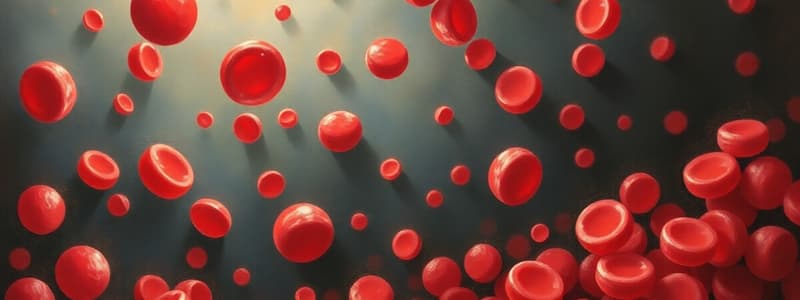Podcast
Questions and Answers
What is the underlying cause of primary polycythemia?
What is the underlying cause of primary polycythemia?
- Increased erythropoietin (EPO) production by the kidneys.
- Cardiovascular diseases that reduce oxygen-carrying capacity.
- A dysfunction within the bone marrow. (correct)
- Low oxygen levels in the blood.
What is the primary mechanism by which secondary polycythemia develops?
What is the primary mechanism by which secondary polycythemia develops?
- Overproduction of erythropoietin (EPO). (correct)
- Decreased erythropoietin (EPO) production.
- Decreased red blood cell production in the bone marrow.
- Dysfunction in the JAK-STAT pathway.
Where is erythropoietin (EPO) primarily produced in the body?
Where is erythropoietin (EPO) primarily produced in the body?
- Bone marrow
- Proximal convoluted tubule of the kidneys (correct)
- Liver
- Spleen
What is the direct physiological consequence of increased red blood cell count in both primary and secondary polycythemia?
What is the direct physiological consequence of increased red blood cell count in both primary and secondary polycythemia?
Which of the following is a potential cause of secondary polycythemia?
Which of the following is a potential cause of secondary polycythemia?
Why is blood doping considered unethical and dangerous?
Why is blood doping considered unethical and dangerous?
What is a common symptom associated with increased blood viscosity in polycythemia?
What is a common symptom associated with increased blood viscosity in polycythemia?
Dysfunction of what pathway is a characteristic of primary polycythemia?
Dysfunction of what pathway is a characteristic of primary polycythemia?
Flashcards
Polycythemia
Polycythemia
The overproduction of red blood cells.
Primary Polycythemia
Primary Polycythemia
Caused by dysfunction in the bone marrow, leading to increased erythropoiesis.
Secondary Polycythemia
Secondary Polycythemia
Caused by overproduction of erythropoietin (EPO).
Erythropoietin (EPO)
Erythropoietin (EPO)
Signup and view all the flashcards
JAK-STAT Pathway
JAK-STAT Pathway
Signup and view all the flashcards
Blood Doping
Blood Doping
Signup and view all the flashcards
Increased Blood Viscosity
Increased Blood Viscosity
Signup and view all the flashcards
Effects of Polycythemia
Effects of Polycythemia
Signup and view all the flashcards
Study Notes
Polycythemia
- Polycythemia is the overproduction of red blood cells.
- Two main types exist: primary polycythemia (polycythemia vera) and secondary polycythemia.
- Primary polycythemia arises from a malfunction in the bone marrow.
- Secondary polycythemia stems from excessive erythropoietin (EPO) production.
Primary Polycythemia (Polycythemia Vera)
- The bone marrow is the source of the problem in primary polycythemia.
- A dysfunction in the JAK-STAT pathway occurs.
- This dysfunction leads to increased erythropoiesis (red blood cell production).
- A mutation in the JAK-STAT pathway is a frequent cause of this hyperfunction.
- Elevated red blood cell count thickens the blood, increasing its viscosity.
- Increased blood viscosity raises the risk of blood clots (thrombi or emboli) and bleeding.
Erythropoietin (EPO) and Secondary Polycythemia
- EPO is produced in the kidneys' proximal convoluted tubule.
- EPO prompts red blood cell production.
- Secondary polycythemia is the result of excessive EPO production.
- Factors causing increased EPO production include:
- Low oxygen levels (e.g., high altitudes).
- Cardiovascular conditions reducing oxygen transport.
- Kidney cancer triggers EPO overproduction.
Blood Doping
- Blood doping involves extracting and storing red blood cells, injecting them back to raise the red blood cell count before competitions.
- Blood doping temporarily increases polycythemia, improving oxygen carrying capacity and athletic endurance.
- Blood doping is unethical and dangerous because it elevates the risk of blood clots.
- Increased blood viscosity from blood doping can lead to strokes or heart attacks.
Key Differences Between Primary and Secondary Polycythemia
- Primary polycythemia (polycythemia vera) arises from a bone marrow issue.
- Secondary polycythemia is driven by high EPO levels.
General Effects of Polycythemia
- Both polycythemia types lead to increased red blood cell count and thicker blood (higher viscosity).
- Increased blood viscosity can cause:
- High blood pressure (hypertension).
- Thromboembolic events (blood clots).
- Increased risk of bleeding.
- Dizziness.
- Headaches.
Studying That Suits You
Use AI to generate personalized quizzes and flashcards to suit your learning preferences.




